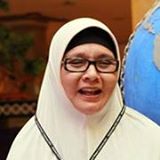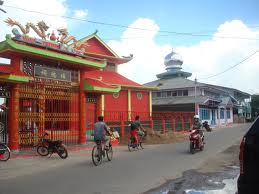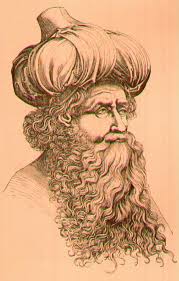“The main objective of the composition of the list to show our debt, European people, to Islam during the Medieval Age… This list not include all of the Arab loan English words at all.” — W. Montgomerry Watt
Note: In bracket it its Indonesian translation.
W. Montgomery Watt
ABYSSINIA — Ar. habashi (Habashah)
ADMIRAL — Ar. amir. al-rahl (pimpinan kafilah), atau amir al-bahr (komandan angkatan laut).
ADOBE — Ar. al-tub (brick)
ALBATROSS — Port. alcadroz — Ar. al-qadus (kendi, burung bentukan).
ALCAIDE, ALCALDE — Ar. al-qa’id
ALCANNA (tanaman yang menghasilkan bahan celup) — Ar. al-hinna’
ALCHEMY — Ar. al-kimiya’ – bahasa Mesir, kemi
ALCOHOL — Ar. al-kuhl, al-kahul (bubuk)
ALCOVE — Sp. alcoba – Ar. al-qubba (kubah)
ALEMBIC — Ar. al-anbiq — Yun. ambix
ALEPPIN (materi) — Aleppo — Ar. halab
ALFA, HALFA (rumput) — Ar. halfa
ALFALFA — Ar. al-fasfasa
ALGEBRA — Ar. al-jabr (aljabar)
ALGORITHM — Ar. al-Khawarizmi (nama orang, penulis kitab Aljabar)
ALKALI — Ar. al-qali (garam abu; kalium karbonat)
ALKANET (tanaman penghasil bahan celup) — Ar. al-hinna’ (pacar)
ALMAGEST — Ar. al-majisti — Yun.
ALMANACH — Ar. al-munakh (cerita, dan lainnya)
ALPACA — Ar. al-, Sp. paco
AMALGAM — Ar. al-malgham — Yun. malagma
AMBER — Ar. ‘anbar
AMICE — Sp. almucio — Ar. al-mustaq — Pers.
ALMULET — (?) Ar. al-hama’il (yang dibawa)
ANILIN — Ar. al-nila (nila) — Sank. nilas
ANTIMONY — Ar. itsmid — Coptic stim
APRICOT — Sp. albaricoque — Ar. — Lat. praecox
ARAB (kuda), ARABESQUE — Ar. ‘arab (Arab)
ARRACK — Ar. ‘araq (secara harfiah: manis)
ARSENAL — Ar. dar al-sina’a
ANTICHOKE — Sp. alcarchofo — Ar. al-kharshuf
ASSASIN — Ar. hashishiyyln, hashshashin (penjual atau pemakai hashish)
ATLAS (pakaian) — Ar. atlas (lembut)
AUBERGINE — Sp. alberengena — Ar. al-badinjan —Pers.
AVERAGE — Sp. averia — Ar. ‘awwar (kalah)
AZIMUTH — Ar. al-sumut (jalan, arah)
AZOTH (air raksa) — Ar. al-dzawuq
AZURE — Ar. lazwardi— Pers.; atau Ar. azraq (biru)
BABOON — Ar. maymun (lutung; kera)
BALCONY — Pers. balakhana (tempat atas) — Ar. bala
BALDACHINO — It. baldacco — Ar. Baghdad
BANANA — Ar. banana (jari)
BARBERRY — Ar. barbaris
BARBICAN — Sp. barbacana — Pers. balakhana — Ar. bala
BARQUE — Port. barroca — Ar. burqa (pasir yang tak rata, d11.)
BARQUE, BARQUENTINE, BRIGANTINE — Sp. barca — Ar. barsha, (barija) — bahasa Mesir, va-ra (kapal matahari)
BEDOUIN — Ar. badawiyyin
BENZINE, dsb. — Ar. luban jawi (bahan bakar di Jawa)
BERBERINE — Ar. barbaris
BERGAMOT — Ar. — Turk. begarmudy (mutiara raja)
BEZOAR — Sp. bezoar — Ar. —Pers. padzahr
BISMUTH — Sp. bismuto — (?) Ar. itsmid (logam putih)
BLOUSE — Lat. Pelusia — Ar. balusi — bahasa Mesir, Palusium
BOMBASINE — Lat. bombacium — Ar. — Pers. panba (kapas) (Turk. pembe)
BORAX — Port. borax — Ar. buraq — Pers. burah
BORAGE — Per. bourrache — Ar. abu-raj (biang keringat)
BUCKRAM, BARCHANT — Ar. barrakan (barang berat)
CABAS (tas kerja) — Ar. qafash
CABAYA — Ar. qaba’ — Pers.
CABLE — Ar. habl (tali)
CADI, CAUZEE — Ar. qadli (hakim)
CALIBRE — Ar. qalib (model)
CALIPH — Sp. califa — Ar. khalifa
CAMEL — Lat. camelus — Ar. jamal (unta)
CAMELIA — Germ. (Josef) Kammel — Ar. jamal
CAMELOT — (materi) — Ar. jamal
CAMPHOR — Ar. kafur — Sank. karpura
CANDY ;— Ar. qand, qandi (juis gula tebu yang diperas)
CAPER — Sp. alcaparra — Ar. kabbar — Yun. kapparis
CARAFE — Sp. garrafa — Ar. gharrafa
CARAT — Port. quirate — Lat. carratus — Ar. qirat
CARAWAY — Ar. karawiyya (atau karawiya’)
CARMINE — Lat. carmesinus — Ar. qirmazi, qirmiz — Sansk. krimija (ulat)
CAROB — Ar. kharruba — ? Asshrian
CHECK — Ar. Pers. shah (raja) (digunakan sebagai nama permainan)
CHECKMATE — Ar. shah mat (raja meninggal)
CHEMISTRY — (as “alchemy”)
CHEQUE — Ar. sakk (perbuatan, kesepakatan tertulis) atau sebagai “chek”
CHESS — Pers. shah
CHIFFON — Per. kuno chiffe — Ar. shiff (pakaian yang bagus).
CID — Ar. sayyid
CINNABAR — Lat. cinnabaris — Ar. zinjafr — Pers.
CIVET (CAT), ZIBET — Ar. zabad
COFFEE — Ar. qahwa
COFFLE (kereta budak-budak) — Ar. qafila
COTTON — Ar. qutun
COFFER — Tua Per. — Ar. quffa — Yun. kophinos
COLCOTHAR — Ar. qulqutar — Yun. khalkanthe
CRAMOISY — Ar. qirmazi — qirmiz
CRIMSON (lihat “carmine”)
CUBEB — Ar. kabab
CUMIN — Yun. kuminos, asalnya sama dengan Ar. kammun —? Asshrian
CUPOLA — Ar. qubba (kubah)
CYPHER — Ar. sifr (nol; kosong)
DAM, DAMBROD (juru gambar, papan gambar) — Sp. ajedrez de la dama, ajedrez atama — Ar. al-shitranj al-tam (catur yang lengkap)
DAMAN (tukang pikul batu) — Ar. daman
DAMASCENE, DAMASK — L. damascenus — Ar. Dimishk
DAMSON — i.e. damascene plum
DATE — Lat. dactylus — Sp. datil — Ar. daqal (inferior date)
DEMI-JOHN — Ital. damigiana — Ar. damajan — Pers.
DHOW — Ar. dawa
DIVAN — Ar. diwan — Pers.
DRAGOMAN — Ar. tarjuman (penterjemah)
DRUG — Ar. durawa (?)
DRUSE — Ar. Duruz
DURRA — Ar. durra
ELEMI — Sp. elemi —Ar. (al-lami)
ELIXIR — Ar. al-iksir — (?) Yun. xeron
FAKIR – Ar. faqir
FANFARE – Ar. farfara (?) (bandingkan dengan Per. fanfaron)
FATAMORGANA – It. – Ar. marjan (batu karang)
FELUCCA – Port. falua Sp. haloque – Ar. harraqa; atau Ar. falaka (berputar), fulk, fuluka
FELLAH, FELLAHEEN – Ar. fallahin
FONDACO (hotel) – It. – Ar. funduq – Yun. pandocheion
FRET (of guitar) – Ar. farida, fard
FRIEZE – Frisco – Ar. ifriz – (?) Yun. Phrygios
GABELLE – Lat. caballa (pajak) – Ar. qabala
GALA – It. – Ar. khil’a (jubah kehormatan)
GALINGALE – Lat. galanga – Ar. khalanjan
GALLANT – Sp. galante (berpakaian yang bagus) – Ar. khil’a
GAMASH (pembalut kaki) – (?) Sp. guadamaci – Ar. ghadamasi (salah satu bentuk kulit)
GAZE, GAUZE -Sp. gasa – Ar. qazz (sutera) – Pers. (mungkin bukan dari Gaza)
GAZELLE – Ar. ghazal
GAZETTE – It. gazzetta (uang logam) – Lat. gaza – Ar. kanz – Pers. ganj (harta benda)
GHAZAL (puisi) – Ar. ghazal
GIAOUR, GUEBRE – Turk. – Pers. gar – (?) Ar. kafir (orang yang tak percaya), atau jawara (orang yang menyimpang)
GILRALTAR – Ar. jabal Tariq (gunung Tariq).
GINGER – Lat. gingiber, zingiber Ar. zanjabil – Sank.
GIRAFFE – Ar. zurafa
GUITAR (Cither, Citole, Gittern, Zither) – Sp. guitarra – Ar. Qitar – Yun. kithara
GYPSUM – Ar. jibs – Yun. gypsos
HAKEEM, HAKIM – Ar. hakim (doctor), hakim (gubernur)
HASHISH – Ar. hashish
HALICHORE, HALALCOR – Pers. – Ar.
HAZARD – Sp. azar – (?) Ar. al-zahr (akar)
HENNA – Ar. hinna’
HOOKA – Ar. huqqa (pipa air)
HOWDAH – Ar. hawdaj
IRADE (dekrit Sultan) – Turk. – Ar. irada (keinginan)
JAR – Ar. jarra
JASMINE – Ar. yasmin – Pers.
JERBOA – Ar. yarbu’
JUMP, JUPE (jaket, korset) – Ar. jubba
JUMPER – Ar. jubba (mungkin)
JULEP (minum) – Ar. julab – Pers. gul-ab
KALIUM (potassium) – Ar. qali
KAVASS, KAWASS (pembantu bersenjata, kurir) – Ar. qawwas
KERMES (insect giving dye) – Ar. qirmiz; bandingkan dengan Carmine
KISMET – Turk. – Ar. qisma (t)
KOHL (celak mata) – Ar. kuhl
LAC, LACQUER, crimson Lake – ? Ar. – Pers. lak atau Turk. laqa Sansk.
LADANUM, (?LAUDANUM) – Lat. – Ar. ladan
LANDAU – Ar. al-andal – Sansk.
LAPIS-LAZULI – Lat. lazulum – Ar. lazwardi – Pers.
LILAC – Ar. – Pers. lilak
LEMON – Ar. limun – Pers.
LOOFAH – Ar. lufa (1887)
LUTE – Ar. al-‘ud
MAGAZINE – Ar. makhazin (jamak dari makhzan)
MAMELUKE – Ar. mamluk (budak)
MANCUS (mata uang) – Ar. manqush
MARABOU (burung bangau) – Ar. murabit
MARABOUT (orang suci) – Ar. murabit, marbut
MARCASITE – Ar. marqashita – Aramaic
MAROQUIN (dibuat dari kulit Maroko): lihat Morocco
MARZIPAN, Marchpane – Ar. mawthaban (raja yang mapan) – Pers. marzuban
MASK, MASQUE, MASQUERADE – Sp. mascara – Ar. maskhara
MAT, MATT – Ar. mat (meninggal)
MATACHIN (penari-pedang dalam pakaian fantasi) – (?) Ar. mutawailihin (memakai kedok)
MATE (dalam dada) – Ar. mat (meninggal)
MATTRESS – It., Sp. – Ar. matrah (tempat di mana sesuatu dibuang)
MINARET – Ar. manara, minara
MOCHA – Ar. Mukha (kota)
MOHAIR – Ar. mukhayyar (pilihan)
MOIRE (pabrik) — Ar. mukhayyar
MONSOON — Port. moncao() — Ar. mawsim (musim)
MOROCCO — Ar. Marakush (kota)
MOSQUE — Per. Kuno mosquette — Sp. mezqueta — Ar. masjid
MULATTO — (?)•Ar. muwallad
MUMMY — Ar. mumiya — Pers. mum (lilin)
MUSCAT, MUSCADINE, MUSCATEL — Provençal, muscat (ks. Of musc) — Ar. musk, atau Masqat
MUSK — Per. musc — Ar. musk — Pers. mushk
MUSKET — Ar. mustaq
MUSLIN — Ar. Mosul, Mawsil (kota)
MYRRH — Ar. Murr, murra
NABOB — Ar. nuwwab, pl. dari naib (wakil)
NACRE (induk mutiara) — Per. kuno nacaire — Ar. naqqara
NADIR — Sp. nadir — Ar. nazir (bertentangan, sc. dari puncak)
NAKER (kettledrum) — Ar. naqqara — Pers. ?
NATRON — Ar. natrun — Yun. — Ibrani nether
NITRE — Ar. natran, nitrun — Yun. nitron — Ibrani
NORIA — (roda air) — Sp. — Ar. na’ura
OGIVE — Lat. augivus, bandingkan It. auge — Ar. ‘awj
ORANGE — Ar. naranj — Pers. narang
OTTOMAN — Turk. — Ar. Uthman
PERCIVAL (nama) — Ar. faris al-fal (pembawa keberuntungan)
POPINJAY — Per. kuno papagai — Ar. babbagha (?)
RACE — Sp. raza — Ar. ra’s (ketua)
RACKET — Per. raquette — Ar. raha (telapak tangan)
RAZZIA — Ar. (dialek) ghaziyya, ghaziya
REALGAR (arsenik merah) — Ar. rahj al-ghar (puing reruntuhan)
REAM — Per. kuno rayme — Ar. rizma
REBEC — It. ribeba, ribeca Ar. rabab
RICE — Sp. Per. kuno ris, — Ar. ruzz, aruzz
RISK — Sp. arrisco, risco — Ar. rizq (rizki)
ROB (buah jeruk dengan madu) Ar. rubb
ROC (burung) — Ar. rukh — ? Malayu
ROCKET — Ar. raha (telapak tangan) (seperti “raket”)
ROOK (dada) — Ar. rukh
SACCHARIN — Lat. saccharum — Ar. Sukkar
SACRE, SAKER (semacam burung elang) — Ar. saqr
SAFARI — Swahili — Ar. safara (bepergian)
SAFFRON — Per. Safran — Ar. za’faran —?
SALEP, SALOP — (anggrek) — Ar. tsa’lab (srigala, testicle of)
SAMBOOK — Ar. sanbuq
SANDALWOOD — Ar. sandal — Sansk.
SAPPHIRE — Ar. safir — Sansk.
SARACEN — Lat. — Ar. sharqi (timur)
SATIN — It. setino — Ar. zaytuni (sifat dari minuman Cina)
SENNA — Ar. sans
SEPOY — Turk. sipilki — Ar. — Pers. sipah (tentara)
SHELLAC bentuk dari “lac” (q.v.)
SHERBET — Turk. sherbet — Ar. sharba (t) (minum)
SHRUB (minuman) — Ar. shurb (minuman)
S(H)UMACH (tanaman) — Ar. summaq
SIROCCO — It. scirocco — Ar. sharq (timur)
SOFA — Per. — Ar. suffa
SORBET — Turk. shorbet — Ar. sharba(t)
SPAHI — Turk. sipale — Ar. — Pers.
SPINACH — Per. Kuno espinage — Ar. isbanakh — Pers. aspanakh
SUGAR — Per. — Ar. sukkar — Sansk. sharkara
SULTAN — Ar. sultan (kekuasaan)
SULTANA — Ar. (istri sultan)
SYRUP — Per. Kuno sirop — Ar. sharab, shurb (minuman)
TABBY (pakaian) — Ar. ‘Attabiyya (bagian dari Baghdad)
TABOR, TABORIN, TABRET (drum) — Ar.? thabl — Pers. taburak
TALC — Ar. talq —? Pers.
TALISMAN — Ar. tilasm — Yun. telesma
TAMARIND — Ar. tamr hindi (penanggalan India)
TAMARISK — Lat. tamariscus — Ar. tamr
TAMBOUR (drum), Tambourine — Ar. — Pers. tabartik
TARE — Ar. tarha (bungkusan yang dibuang)
TARIFF — It. tariffa — Ar. ta’rif (pemberitahuan)
TAROT (kartu) — It. tarocco — ? Ar.
TARRAGON — Lat. tarchon — Ar. tarkan — Pers.
TASS, TASSIE — Per. tasse — Ar. tass, tassa — Pers. tasht (selat)
TEAK — Port. teca — Ar. saj dan Tamil tekku — Sank. saka
TOQUE — Ital. tocca Ar. taqiya (under-cap)
TROUBADOR — ? Ar. tarrab (penyanyi); taraba (menyanyi)
TURBITH, TURPETH – AR. Turbadh
TUTTY – Ar. tutiya’ (timah oksid)
VIZIR – Ar. wazir
WAD – Per. ouate – Ar. batin
ZEBOARY – Ar. zidwar
ZENITH – Per. kuno cenit – Ar. samt (al-ra’s; pemimpin)
ZERO – It. zero, zefro – Ar. sifr. (nol)
ZIRCON – Ar. azraq (biru)
ZOUAVE – zawawa (nama suku)
Source: W. Montgomery Watt, Islam dan Peradaban Dunia: Pengaruh Islam Atas Eropa Abad Pertengahan, Indonesian translation from: The Influence of Islam on Medieval Europe,1972. Jakarta: Gramedia, 1995. Penerjemah: Hendro Prasetyo. Pengantar: Dr. Nurcholish Madjid. Apendix, pp 125-134. See also: http://blogs.transparent.com/arabic/top-50-english-words-of-arabic-origin/ & http://en.wikipedia.org/wiki/List_of_English_words_of_Arabic_origin

















































































































